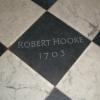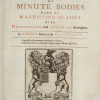Hooke's microscope, 1665
Commentary
For his observations, Robert Hooke made use of a compound microscope designed by the London instrument maker Christopher Cock. The first compound microscopes were developed by Galileo and Giuseppe Campani in Italy (1624-1625), and featured three lenses: a bi-convex objective lens placed in the snout and two additional lenses, an eyepiece lens and a field lens fitted in the tube. Cock's design followed this basic Galilean model. The three of the lenses together offered a good view of a sizeable object, but Hooke found that the resolution was poor:
The Microscope,... was contriv'd with three Glasses; a small Object Glass..., a thinner Eye Glass..., and a very deep one...: This I made use of only when I had occasion to see much of an Object at once; the middle Glass conveying a very great company of radiating Pencils, which would go another way, and throwing them upon the deep Eye Glass.
To obtain better resolution, Hooke had to remove the middle (field) lens:
But when ever I had occasion to examine the small parts of a Body more accurately, I took out the middle Glass, and only made use of one Eye Glass with the Object Glass, for always the fewer the Refractions are, the more bright and clear the Object appears.
For illumination purposes, Hooke designed an ingenious method of concentrating light on his specimens. He passed light generated from an oil lamp through a water-filled glass flask to diffuse the light and provide better illumination for the samples.
For a three-dimensional view of Hooke's microscope, see the video embedded below.
Image 1. Engraving of Hooke's microscope, first plate (Schem. I) in Robert Hooke, Micrographia: or, Some physiological descriptions of minute bodies made by magnifying glasses. London: J. Martyn and J. Allestry, 1665. Source: National Library of Wales via Wikimedia. Copyright: Public domain.
Image 2. Full size copy of Robert Hooke's original compound microscope with illuminating system, probably made by John Mayall in the 1880s and purchased by the Science Museum in 1927. Source: Science Museum. Copyright: CC BY-SA 4.0.
Credit: Georgiana Hedesan (June 2018)
Material on Hooke's famous Micrographia (1665) is available here.
Pugliese, Patri (2006), 'Robert Hooke', in Oxford Dictionary of National Biography, available freely to Oxford students.


